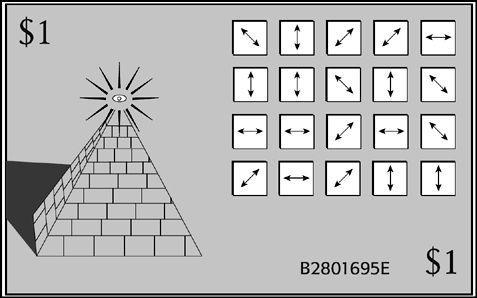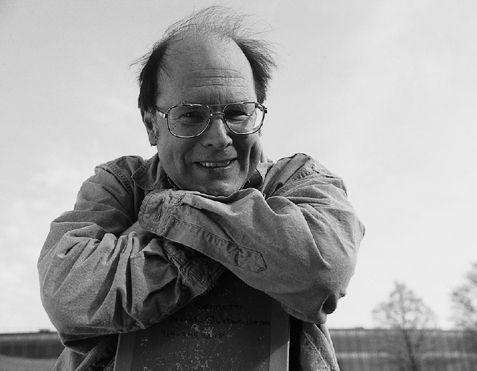The Code Book (57 page)


Figure 74
Stephen Wiesner’s quantum money. Each note is unique because of its serial number, which can be seen easily, and the 20 light traps, whose contents are a mystery. The light traps contain photons of various polarizations. The bank knows the sequence of polarizations corresponding to each serial number, but a counterfeiter does not.
The counterfeiter’s problem is that he must use the correct orientation of Polaroid filter to identify a photon’s polarization, but he does not know which orientation to use because he does not know the polarization of the photon. This catch-22 is an inherent part of the physics of photons. Imagine that the counterfeiter chooses a -filter to measure the photon emerging from the second light trap, and the photon does not pass through the filter. The counterfeiter can be sure that the photon was not
-filter to measure the photon emerging from the second light trap, and the photon does not pass through the filter. The counterfeiter can be sure that the photon was not -polarized, because that type of photon would have passed through. However, the counterfeiter cannot tell whether the photon was
-polarized, because that type of photon would have passed through. However, the counterfeiter cannot tell whether the photon was -polarized, which would certainly not have passed through the filter, or whether it was
-polarized, which would certainly not have passed through the filter, or whether it was or
or -polarized, either of which stood a fifty-fifty chance of being blocked.
-polarized, either of which stood a fifty-fifty chance of being blocked.
This difficulty in measuring photons is one aspect of the uncertainty principle, developed in the 1920s by the German physicist Werner Heisenberg. He translated his highly technical proposition into a simple statement: “We
cannot
know, as a matter of principle, the present in all its details.” This does not mean that we cannot know everything because we do not have enough measuring equipment, or because our equipment is poorly designed. Instead, Heisenberg was stating that it is logically impossible to measure every aspect of a particular object with perfect accuracy. In this particular case, we cannot measure every aspect of the photons within the light traps with perfect accuracy. The uncertainty principle is another weird consequence of quantum theory.
Wiesner’s quantum money relied on the fact that counterfeiting is a two-stage process: first the counterfeiter needs to measure the original note with great accuracy, and then he has to replicate it. By incorporating photons in the design of the dollar bill, Wiesner was making the bill impossible to measure accurately, and hence creating a barrier to counterfeiting.
A naive counterfeiter might think that if he cannot measure the polarizations of the photons in the light traps, then neither can the bank. He might try manufacturing dollar bills by filling the light traps with an arbitrary sequence of polarizations. However, the bank is able to verify which bills are genuine. The bank looks at the serial number, then consults its confidential master list to see which photons should be in which light traps. Because the bank knows which polarizations to expect in each light trap, it can correctly orient the Polaroid filter for each light trap and perform an accurate measurement. If the bill is counterfeit, the counterfeiter’s arbitrary polarizations will lead to incorrect measurements and the bill will stand out as a forgery. For example, if the bank uses a ↕-filter to measure what should be a ↕-polarized photon, but finds that the filter blocks the photon, then it knows that a counterfeiter has filled the trap with the wrong photon. If, however, the bill turns out to be genuine, then the bank refills the light traps with the appropriate photons and puts it back into circulation.
In short, the counterfeiter cannot measure the polarizations in a genuine bill because he does not know which type of photon is in each light trap, and cannot therefore know how to orient the Polaroid filter in order to measure it correctly. On the other hand, the bank is able to check the polarizations in a genuine bill, because it originally chose the polarizations, and so knows how to orient the Polaroid filter for each one.
Quantum money is a brilliant idea. It is also wholly impractical. To start with, engineers have not yet developed the technology for trapping photons in a particular polarized state for a sufficiently long period of time. Even if the technology did exist, it would be too expensive to implement it. It might cost in the region of $1 million to protect each dollar bill. Despite its impracticality, quantum money applied quantum theory in an intriguing and imaginative way, so despite the lack of encouragement from his thesis adviser, Wiesner submitted a paper to a scientific journal. It was rejected. He submitted it to three other journals, and it was rejected three more times. Wiesner claims that they simply did not understand the physics.
It seemed that only one person shared Wiesner’s excitement for the concept of quantum money. This was an old friend by the name of Charles Bennett, who several years earlier had been an undergraduate with him at Brandeis University. Bennett’s curiosity about every aspect of science is one of the most remarkable things about his personality. He says he knew at the age of three that he wanted to be a scientist, and his childhood enthusiasm for the subject was not lost on his mother. One day she returned home to find a pan containing a weird stew bubbling on the cooker. Fortunately she was not tempted to taste it, as it turned out to be the remains of a turtle that the young Bennett was boiling in alkali in order to strip the flesh from the bones, thereby obtaining a perfect specimen of a turtle skeleton. During his teenage years, Bennett’s curiosity moved from biology to biochemistry, and by the time he got to Brandeis he had decided to major in chemistry. At graduate school he concentrated on physical chemistry, then went on to do research in physics, mathematics, logic and, finally, computer science.

Figure 75
Charles Bennett. (
photo credit 8.2
)
Aware of Bennett’s broad range of interests, Wiesner hoped that he would appreciate quantum money, and handed him a copy of his rejected manuscript. Bennett was immediately fascinated by the concept, and considered it one of most beautiful ideas he had ever seen. Over the next decade he would occasionally reread the manuscript, wondering if there was a way to turn something so ingenious into something that was also useful. Even when he became a research fellow at IBM’s Thomas J. Watson Laboratories in the early 1980s, Bennett still could not stop thinking about Wiesner’s idea. The journals might not want to publish it, but Bennett was obsessed by it.
One day, Bennett explained the concept of quantum money to Gilles Brassard, a computer scientist at the University of Montreal. Bennett and Brassard, who had collaborated on various research projects, discussed the intricacies of Wiesner’s paper over and over again. Gradually they began to see that Wiesner’s idea might have an application in cryptography. For Eve to decipher an encrypted message between Alice and Bob, she must first intercept it, which means that she must somehow accurately perceive the contents of the transmission. Wiesner’s quantum money was secure because it was impossible to accurately perceive the polarizations of the photons trapped in the dollar bill. Bennett and Brassard wondered what would happen if an encrypted message was represented and transmitted by a series of polarized photons. In theory, it seemed that Eve would be unable to accurately read the encrypted message, and if she could not read the encrypted message, then she could not decipher it.
Bennett and Brassard began to concoct a system based on the following principle. Imagine that Alice wants to send Bob an encrypted message, which consists of a series of 1’s and 0’s. She represents the 1’s and 0’s by sending photons with certain polarizations. Alice has two possible schemes for associating photon polarizations with 1 or 0. In the first scheme, called the
rectilinear
or +-scheme, she sends to represent 1, and
to represent 1, and to represent 0. In the other scheme, called the
to represent 0. In the other scheme, called the
diagonal
or ×-scheme, she sends to represent 1, and
to represent 1, and to represent 0. To send a binary message, she switches between these two schemes in an unpredictable way. Hence, the binary message 1101101001 could be transmitted as follows:
to represent 0. To send a binary message, she switches between these two schemes in an unpredictable way. Hence, the binary message 1101101001 could be transmitted as follows: